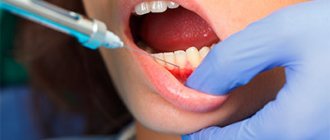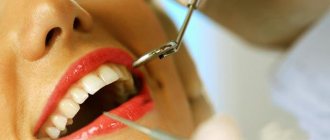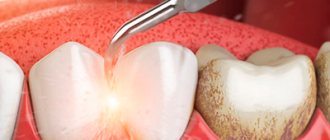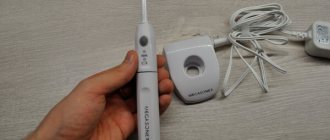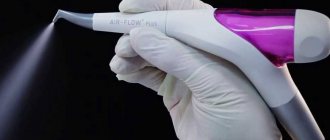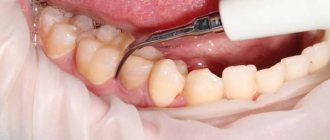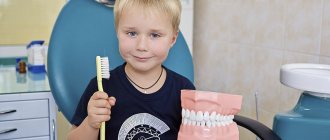Almost everyone would like to have a beautiful, dazzling smile. But, unfortunately, poor quality nutrition, bad habits, excessive consumption of coffee or even tea contribute to the fact that over time the teeth turn yellowish. Also, the above reasons contribute to the formation of hard plaque in the oral cavity.
The solution to this problem is comprehensive cleaning of the entire oral cavity, which not only helps remove plaque, but also improves the health of periodontal tissue and prevents the development of various oral diseases. One of the main stages of cleaning is sandblasting the cleansing of tooth enamel. The main goal is to remove pigmented plaque from tooth enamel, which is impossible to clean off on your own. Sandblasting helps lighten the enamel to its original color.
In addition to the aesthetic side, regular removal of dental plaque prevents the development of many dental diseases. After the procedure, you need to adhere to a white diet for the first 48 hours. You need to stop eating coloring foods, such as tea, coffee, red wine, beets, berries, etc.
The procedure is recommended for everyone; it is recommended to do it before any dental treatment, and also as a preventive measure for the development of pathologies, every six months.
As a rule, sandblasting teeth cleaning is performed as part of general oral cleaning.
How does the procedure take place?
As we have already said, this method allows you to effectively remove a not too thick layer of plaque and tartar, so if you have massive supra- and subgingival dental plaque, the dentist will first do ultrasonic cleaning of the deposits. And only after that, with the help of Air flow, it will remove all remnants of plaque, pigment spots from the teeth, and polish the teeth.
The duration of the procedure depends on the number of teeth, the degree of their contamination, and the density of plaque. But on average it ranges from 30 to 60 minutes. First, the patient's lips are lubricated with Vaseline to prevent them from drying out, and a saliva ejector is placed under the tongue. You may feel slight pain during the procedure if you have sensitive tooth necks.
Air flow teeth cleaning requires protecting the patient's eyes from microbes that are carried out of the mouth by the air flow, as well as from accidental ingress of abrasive particles. Therefore, patients wear safety glasses before the procedure, and wear a cap to keep their hair clean.
Air flow teeth cleaning: video procedure
Important: in the first 3 hours after the procedure, you will not drink coffee and tea, smoke or eat foods that stain tooth enamel (for example, wine, beets...). It would be ideal if you purchase an electric toothbrush to maintain the whiteness of your teeth. This brush is especially necessary for smokers and strong tea/coffee lovers.
What is this procedure
Sandblasting teeth cleaning is one of the important methods that is performed in the dentist's office. It involves cleansing the teeth from plaque and hard deposits. It is performed using a professional device - sandblasting, which directs the flow of a special product onto the surface of the dentition.
Daily hygiene sessions do not provide complete cleansing of impurities. Therefore, it is necessary to contact your dentist for additional cleaning procedures. The purpose of sandblasting is to remove dirt and deposits in hard-to-reach areas. Using sand cleansing, you can get rid of soft and hard deposits and prevent the development of caries, gingivitis, and periodontitis. Also, getting rid of sand deposits is a preparatory step for bleaching.
Before conducting a cleansing session using the device, you need to consult a specialist. This procedure has the following steps:
- Removing deposits. The doctor cleanses the stone using manual, ultrasound or laser methods.
- Cleaning with sandblasting. The dentist uses an Air Flow sandblasting machine, which creates air-water flows and delivers special powder under pressure. This product gets rid of dirt in hard-to-reach areas. The duration of the procedure is no more than half an hour.
- Polishing and fluoridation. With these actions, the enamel becomes protected from caries.
After passing, you should not drink coffee, tea or other products that can cause pigmentation on the enamel for three hours. Smoking and eating citrus fruits are also prohibited. It is recommended to undergo this procedure twice a year.
Air Flow cleaning: how it works
As we have already said: the device creates a mixture of compressed air, water and particles of a fine abrasive substance (sodium bicarbonate). This mixture is applied to the teeth under high pressure. Particles of sodium bicarbonate hit the plaque, as if knocking it off the enamel, and the water-air spray washes away the abrasive particles and fragments of the removed plaque.
When using this method, damage to tooth enamel is completely eliminated due to the size and special shape of sodium bicarbonate granules. In addition, for patients with damaged or particularly sensitive enamel, it is possible to use the “Air-Flow Soft” powder version, which contains an abrasive with a smaller particle size.
However, the manufacturer guarantees that when using Air-Flow Classic powder, which has a standard abrasive particle size, you will not get scratches on the surface of your teeth. This is achieved by giving the abrasive particles a rounded shape, carried out using special equipment.
Which teeth cleaning is better - ultrasonic or sandblasting?
There are many technologies used for professional cleaning of the oral cavity today. Laser methods, gels, ultrasound, and sandblasting manipulations are actively used. Professional teeth cleaning with a sandblaster has no direct alternatives, since this is not the main method, but an additional one that can remove tartar. Ultrasonic cleaning is used in combination with sandblasting type manipulation.
The procedure using ultrasound includes the cleaning itself and further polishing of the crowns. Its main advantages are the effective removal of plaque and stone, the prevention of gum tissue diseases. With prolonged and frequent use, microdamages may remain on the enamel. Therefore, this method was replaced by a new method using a device such as Air Flow. The technology does not cause pain in most patients. The procedure is non-contact, which does not cause microcracks in the enamel. It is highly effective in combating stains, plaque, and microbial colonies. This prevents the development of caries and the appearance of hard plaque.
Teeth cleaning with Air Flow equipment: what it is, application, what cleaning gives - MEDSI
Table of contents
- Basics of the method
- When is Air Flow cleaning needed?
- How to clean with the Air Flow system
- Advantages and disadvantages of Air Flow
- Contraindications to the procedure
- Advantages of carrying out the procedure at MEDSI
The Air Flow device is a device that is used for professional, gentle cleaning of teeth from plaque and various deposits.
Basics of the method
Air Flow hygienic teeth cleaning is a procedure in which the device sprays a mixture of water, air and special powder crystals under pressure onto the teeth. The degree of such pressure is regulated by the dentist. Using this device, various types of deposits are removed not only from the surface of the teeth, but also from the interdental spaces.
This is a safe and painless method of professional cleaning that does not damage the enamel. After using it, teeth become lighter. For greater patient comfort, fruit-flavored powder is used.
When is Air Flow cleaning needed?
Air Flow oral cleaning is necessary in situations where you need to clean hard-to-reach areas of the jaws, gums and teeth, as well as before various types of medical interventions.
Therefore, removing dental plaque using the Air Flow method is necessary in the following cases:
- The need to install or remove crowns, implants or braces
- The appearance of gum problems - the first signs of periodontal disease
- It is necessary to properly clean installed implants, braces, etc.
- Yellowing of enamel due to drinks and other substances (tea, coffee, cigarettes, etc.)
- The teeth are located very tightly, there is crowding of the dentition
As a result of the procedure, it is possible not only to completely clean the implants or braces, but also to avoid the development of oral diseases such as caries, periodontitis, periodontal disease, periostitis, gingivitis and others.
How to clean with the Air Flow system
Since Air Flow cannot remove extremely hard particles of old tartar, it is used in combination with other methods of cleaning and polishing teeth. All of them are included in the list of procedures used for professional cleaning by a dentist.
The standard comprehensive procedure goes like this:
- Before brushing, the patient must brush his teeth
- At the beginning of the session, the doctor assesses the condition of the patient’s jaw, gums and oral cavity
- Then he removes hard plaque and stone not only from the teeth, but also from under the gums using an ultrasonic device - a scaler; This part of the procedure may be painful for the patient, so they may be asked to apply local anesthesia
- The third stage of cleaning is the removal of pigmented plaque formed from eating food, drinks, smoking, using the Air Flow system
- After this, the doctor cleans the interdental spaces using floss (dental floss) or strip (abrasive tape)
- At the end of the procedure, the surface of the teeth is polished with special brushes, and fluoride-containing compounds are also applied to them to strengthen the enamel and reduce sensitivity.
After professional cleaning of the patient’s chewing apparatus using the Air Flow system, MEDSI dentists provide recommendations on gum care, from choosing a brush and irrigators to individual selection of toothpaste. Doctors advise repeating the procedure at least 1-2 times a year.
Advantages and disadvantages of Air Flow
Advantages of the method of cleaning teeth using this device:
- Dentures, braces and other orthodontic structures are completely cleaned, which is impossible to achieve with conventional methods
- The device allows you to maximally clean hard-to-reach subgingival and supragingival areas from plaque
- The procedure takes about half an hour
- Using Air Flow does not cause discomfort or pain
- The enamel is brightened, pigment spots are eliminated
- This cleaning helps eliminate bad breath (if it is not caused by other diseases)
Minuses:
- The Air Flow device is not able to independently remove old dense tartar
Contraindications to the procedure
Hygienic teeth cleaning using Air Flow cannot be carried out if:
- allergies to soda or components of polishing mixtures
- colds, flu and other viral diseases
Advantages of carrying out the procedure at MEDSI
- Modern systems for professional teeth cleaning, suitable even for sensitive gums
- Highly qualified dentists
- Wide network of clinics and convenient opening hours
You can sign up for the procedure at any time by calling 8 (495) 7-800-500
Why is sandblasting necessary?
Sandblasting is useful if you want to preserve the aesthetic appearance of our teeth.
This also works well when we want to prevent bacteria from growing in hard-to-reach places that a toothbrush can't reach. Reaching hard to reach areas and removing discoloration are the main benefits of this treatment. You can treat sandblasting as a preventative treatment, but only if you actually see residue on your teeth. Dentists view sandblasting as a teeth whitening treatment and as an anti-scaling supplement.
Good to know:
what is supragingival and subgingival scaling?
How often should sandblasting be carried out and for whom is the procedure intended?
Sandblasting may even be done every few months, depending on the condition of the teeth and the patient's lifestyle.
Sandblasting is intended mainly for smokers and people who drink a lot of coffee and strong tea. More frequent sandblasting is also recommended for people wearing an orthodontic device.
